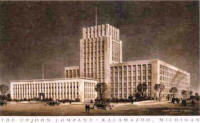

KALAMAZOO COUNTY, MI
GENEALOGY & LOCAL HISTORY
COUNTY HISTORY PAGE 7
 Upjohn Company Headquarters, 1938 |
Click on image to enlarge
| The Upjohn Company | Gilmore Brothers |
|
In 1886, the Upjohn Company was established - succeeded by Pharmacia and, subsequently by Pfizer. Along with the state institutions, it has been the pillar of employment in Kalamazoo County.
Two historical markers on the Kalamazoo Mall note the importance of the importance of the Upjohn Company and its founder, W. E. Upjohn. See: History of the W. E. Upjohn Institute for Employment ; the KPL Biography of W. E. Upjohn ; the History of the Kalamazoo Foundation ; and A Brief Biography of W. E. Upjohn. Patrick Norris, Director of the Kalamazoo Valley Museum, has written about the early life of W. E. Upjohn in the Museum's publication, Museograpy Volume 3, Issue 2, Winter 2004 - History by the Ounce - Hasting and Young Dr. Upjohn, summarized here: William Erastus Upjohn, the son of Dr. Uriah Upjohn, was born in 1853. Uriah Upjohn, emigrated from England, received his medical degree in New York City, and, together with his brothers, moved to frontier Richland, Michigan in the 1830's. Uriah served as a horseback physician to the pioneers and produced remedies from bulk chemicals and medicinal plants. He married Maria Mills from Richland - see her obituary on the Pioneer Society Obituaries pages. He maintained a life long interest in the practical application of science that he passed on to his children. Four of his children, including William, graduated from the University of Michigan medical school. Uriah purchased a house in Ann Arbor, moving his family there when his oldest son entered college. W. E. worked in a pharmacy while his older brother attended college. After receiving his medical degree in 1875, W. E. joined his uncle William's practice in Hasting. He married and had four children, Winifred Upjohn Light, William Harold Upjohn, Dorothy Upjohn Dalton, and Genevieve Upjohn Gilmore - names to become well known in Kalamazoo. During his 10 year practice in Hasting, W. E. conducted his own research into the making of medicines. He used his ingenuity to solve two problems with existing medicines: "how to deliver medicine that would dissolve in the body and how to insure precise control over the amount and quality of the active ingredients." "Struck, he later wrote, by 'the impulse to produce something better adapted to the use of the country physician,' he invented a new way of making and delivering medicine. Rather than start with a paste, Dr. Upjohn introduced a starter particle into a revolving pan. As the pan revolved, the starter was sprayed with powdered medicine and a fine mist, gradually accumulating into a pill of appropriate dosage. Dr. Upjohn built his new pill layer by layer, like a snowball rolling down a hill. The resulting product was essentially dry to begin with and could not dry out over time. It easily dissolved when ingested. It was also friable; it could be crushed under your thumb." Dr. W. E. Upjohn received a patent for his process in 1885 and founded his pharmaceutical company. Upjohn expanded its manufacturing facilities to Portage in the 1950's, but maintained research facilities in downtown Kalamazoo.
|
|
Gilmore Bros, dry goods, cloaks, notions, carpets, men’s furnishings In 1881 John Gilmore, soon joined by his brother James, opened a dry goods store on Burdick Street. Gilmore Brothers grew throughout the 19th century, expanding the goods offered for sale and the facility that housed them. Carrie Gilmore, widow of James, expanded the store into the building shown in the 1913 photograph shown below. In 1913, Carrie married W. E. Upjohn linking the best known families in Kalamazoo. Until the post World War II retailing changes, shopping in Kalamazoo usually meant the big downtown department stores and Gilmore's, the largest of all.
In 1959
Kalamazoo attempted to meet the challenge of suburban malls, super stores
and discount stores with a pedestrian mall on Burdick St. naturally with
Gilmore's as the anchor retailer - See the
Kalamazoo Mall page.
In 1980, Kalamazoo, including the downtown area and Gilmore Brothers, was struck by a strong tornado - See the Kalamazoo Tornado page. Gilmore Brothers was resolute in its support of downtown retailing:
At the store's 100th anniversary in 1981, Irving Gilmore
said "Gilmore's is Kalamazoo," according to an account in the book 'Kalamazoo:
The Place Behind the Products.' "We have been in the heart of downtown
Kalamazoo for 100 years and plan to be here for at least another 100. -
Kalamazoo Gazette. "Gilmore's has struggled in recent years, closing its department store in Battle Creek's Lakeview Square Mall in 1994 and Gilmore's locations at Maple Hill Mall and Southland Mall in 1995. The closings left the flagship downtown Kalamazoo department store as the last Gilmore's store. Economics make it impossible to profitably maintain such a large, single-unit, independent department store in a downtown environment... Since its inception Gilmore's maintained a loyal following by offering personalized service, competitive prices on high-quality merchandise and a first-rate sales staff with clerks often greeting regulars by name and treating strangers like regulars. "This has been a painful decision," said Parfet, in prepared comments. "However, once a decision such as this is made, it is better for all involved to move forward as prudently as possible" - Kalamazoo Gazette.
Final sale at Gilmore's building: Wrecker rescues old
bowling alley hidden in department store's interior
|
All rights reserved.
This site may be freely linked to but not duplicated
in any fashion without
my consent.
The information on these pages is meant for personal genealogical
research only and is not for commercial use of any type.